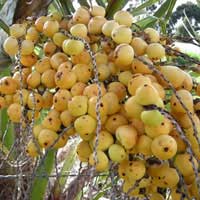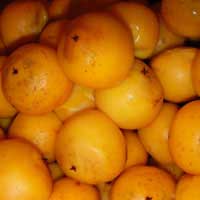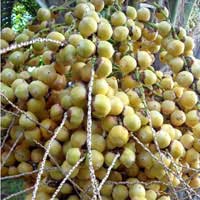 Full List of Fruits
Full List of Fruits  Jelly Palm
Jelly PalmJelly Palm
Scientific name - Butia capitata
Jelly Palm is endemic to Argentina, Brazil and Uruguay. It is a slow growing plant that can reach the maximum height of 8m. The species can be easily identified by its distinguished palm pinnate leaves. Jelly Palm is noted as one of the hardiest feather palms as it could tolerate the temperature of about-10 °C.
Ripe fruit appears in dark yellowish/orange color with its size resembling exact to cherry. The fruit possesses a unique taste which is of the combination of pineapple, apricot, and vanilla. Its flesh appears similar to a loquat but bit fibrous.
The tree grows well under a moderate shade and moisture which needs regular watering as it can develop healthy only in the drained soil. The pindo palm needs a warmer Zone to get developed into a gigantic tree and often is not a characterized tree of subtropical and tropical zones.
![]() Nutritional Value of Jelly Palm
Nutritional Value of Jelly Palm
| Nutritions | Value |
| Calories | 305 calories. |
| Fat | 24 grams of fat, of which 16 grams are saturated fat. |
| Carbohydrates | 28 grams of carbohydrates, of which 24 grams are sugars. |
| Protein | 1 gram of protein. |
| Vitamins and Minerals | vitamin A, vitamin E, thiamin, niacin, phosphorus, potassium, and magnesium. |
| Fiber | 1.5 grams |
Jelly Palm, also known as jelly-palm, is a tropical fruit native to Southeast Asia, India, and Sri Lanka. It was first documented by French botanist Jean Baptiste Lamarck in 1790. The fruit is typically found near the coastlines of these regions and is highly valued for its jelly-like texture and sweet taste.
The jelly palm is a medium-sized palm tree, growing up to 30 feet in height and producing clusters of small, yellow-green fruits. The fruits contain a single, white seed surrounded by a thick, jelly-like pulp. The pulp is edible and very sweet in taste, and has a consistency similar to that of an orange.
Jelly palm is generally available fresh in the markets of Southeast Asia, India, and Sri Lanka. It can also be canned, frozen, and dried. The canned variety is usually sweetened with sugar and often used in desserts, cakes, and ice creams. The dried fruit is often used as a topping for various dishes.
In India, jelly palm is known as "kalpasi" and is used in traditional Ayurvedic medicine to treat a variety of ailments, including indigestion, fever, and stomachaches. It is also believed to have anti-inflammatory properties and is used to treat wounds and skin conditions.
In Sri Lanka, jelly palm is known as "kalai" and is used to make a sweet syrup called "palm jaggery." This syrup is used to sweeten desserts, cakes, and other treats. It is also believed to have medicinal properties and is used to treat various ailments such as indigestion, fever, and stomachaches.
Jelly palm trees grow best in areas with plenty of sunlight and well-drained soil. They can be propagated by either seed or cutting. Seeds should be planted in moist, fertile soil and kept well watered. Cuttings should be taken from young, healthy plants and planted in moist soil and kept well watered.
Jelly palm fruits are a popular ingredient in many Southeast Asian dishes. The pulp is often added to salads, curries, and other savory dishes. It can also be used to make jams, jellies, and other desserts.
The jelly palm tree has been cultivated for centuries and is an important source of food and income for many people in tropical countries. It is an important source of nutrition, providing essential vitamins and minerals, as well as a delicious and unique flavor. Jelly palm is a versatile and delicious fruit that is easy to grow and has many uses in the kitchen.


















